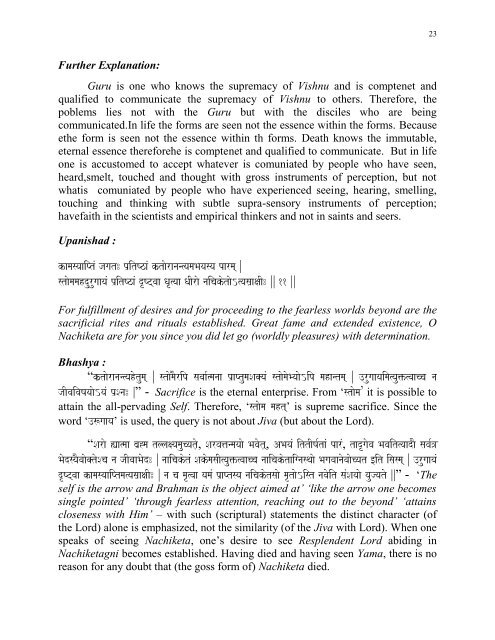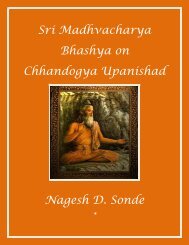You also want an ePaper? Increase the reach of your titles
YUMPU automatically turns print PDFs into web optimized ePapers that Google loves.
Further Explanation:<br />
Guru is one who knows the supremacy of <strong>Vishnu</strong> and is comptenet and<br />
qualified to communicate the supremacy of <strong>Vishnu</strong> to others. Therefore, the<br />
poblems lies not with the Guru but with the disciles who are being<br />
communicated.In life the forms are seen not the essence within the forms. Because<br />
ethe form is seen not the essence within th forms. Death knows the immutable,<br />
eternal essence thereforehe is comptenet and qualified to communicate. But in life<br />
one is accustomed to accept whatever is comuniated by people who have seen,<br />
heard,smelt, touched and thought with gross instruments of perception, but not<br />
whatis comuniated by people who have experienced seeing, hearing, smelling,<br />
touching and thinking with subtle supra-sensory instruments of perception;<br />
havefaith in the scientists and empirical thinkers and not in saints and seers.<br />
Upanishad :<br />
kamasyaaiPtM jagat: p`itYzaM k`taoranan%yamaBayasya parma\ |<br />
staomamahdurugaayaM p`itYzaM dRYT\vaa QaR%yaa QaIrao naicakotao|%yasa`axaI: || 11 ||<br />
For fulfillment of desires and for proceeding to the fearless worlds beyond are the<br />
sacrificial rites and rituals established. Great fame and extended existence, O<br />
Nachiketa are for you since you did let go (worldly pleasures) with determination.<br />
Bhashya :<br />
“k`taoranan%yahotuma\ | staomaOrip savaa-%manaa p`aPtumaSa@yaM staomaoByaao|ip mahantma\ | ]rugaayaima%yau>%vaacca na<br />
jaIvaivaYayaao|yaM p`Sna: |” - Sacrifice is the eternal enterprise. From „staoma’ it is possible to<br />
attain the all-pervading Self. Therefore, „staoma maht\‟ is supreme sacrifice. Since the<br />
word „]$gaaya‟ is used, the query is not about Jiva (but about the Lord).<br />
“Sarao (a%maa ba`*ma tllaxyamaucyato,, Sarva%vaacca naaicakotaignasqaao Bagavaanaovaaocyat [it isasma\ | ]rugaayaM<br />
dRYT\vaa kamasyaaiPtma%yasa`axaI: | na ca maR%vaa yamaM p`aPtsya naicakotsaao maRtao|ist navaoit saMSayaao yaujyato ||” - „The<br />
self is the arrow and Brahman is the object aimed at‟ „like the arrow one becomes<br />
single pointed‟ „through fearless attention, reaching out to the beyond‟ „attains<br />
closeness with Him‟ – with such (scriptural) statements the distinct character (of<br />
the Lord) alone is emphasized, not the similarity (of the Jiva with Lord). When one<br />
speaks of seeing Nachiketa, one‟s desire to see Resplendent Lord abiding in<br />
Nachiketagni becomes established. Having died and having seen Yama, there is no<br />
reason for any doubt that (the goss form of) Nachiketa died.<br />
23




